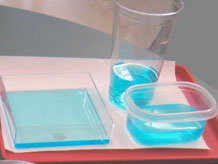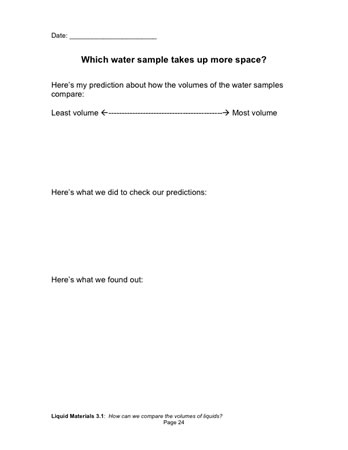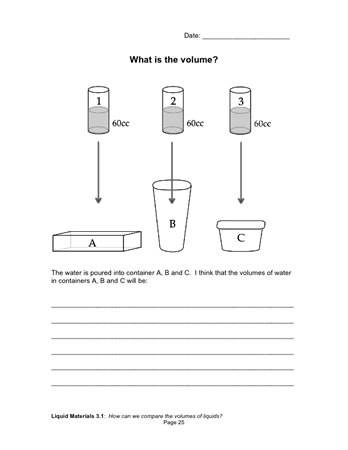How can we compare the volumes of liquids?
Plan Investigation 3.1

Water in a round container … Water in a square container … Water in a curvy container … How can we compare the volumes when the shapes keep changing?
Formative Assessment
Available online at inquiryproject.terc.edu
Students consider three containers of water and compare the volumes using only their senses. They predict the volume order then check it using strategies they devise themselves, e.g., transferring the liquids to three identical containers, or marking the level of each liquid in a fourth container. They consider whether liquids keep their volume as they change containers.
By the end of this investigation students will understand that liquids take the shape of their containers, that a standard–sized container makes it easier to compare volumes, and that volume is conserved no matter what container holds the liquid.
Learning Goals
- Recall that volume is the amount of three–dimensional space a material takes up
- See that liquids take the shape of their container
- See that the volume of liquids does not change with the shape of the container
| Sequence of experiences | ||
|---|---|---|
| 1. Ask the question | Discussion | 10 Mins |
| 2. Predict volume order | Small Groups | 10 Mins |
| 3. Test predictions | Small Groups | 10 Mins |
| 4. Make meaning | Discussion | 15 Mins |
Materials and Preparation
For the class:- Post the investigation question in a place where all students can see it.
- Prepare a class table for recording the groups' predicted volume orders; an example is found in Step 2.
- 1 capped 150cc container with exactly 40cc of fresh water*
- 1 capped 150cc container with exactly 40cc of mineral oil*
- 1 capped 150cc container with 40cc of sand*
- 1 capped 150cc container with 40cc of organic soil*
- 1 capped 150cc container with 40cc of gravel*
- blue food coloring
* These 5 containers of materials were also used in the last investigation.

- 1 set of 3 containers, each filled with 250cc of blue–tinted water
- 1 wide, shallow rectangular container, marked "A"
- 1 narrow, tall rectangular container, marked "B"
- 1 20oz cup, marked "C"
- 2 additional 20oz cups, empty (if the group asks for these)
Do students understand that the volume of a liquid stays the same no matter what container holds the sample?
As the class discusses how they compared the volumes of A, B, and C, listen for evidence that students understand:
- The value of using identical containers to compare the volumes of different samples of liquids.
- That the volume of a liquid stays the same no matter what the shape of the container.
How would you interpret this student’s claim and evidence?
As a next step you might ask, “Is there ever a time when the volume wouldn’t be the same when you poured it into a different shaped container?”








